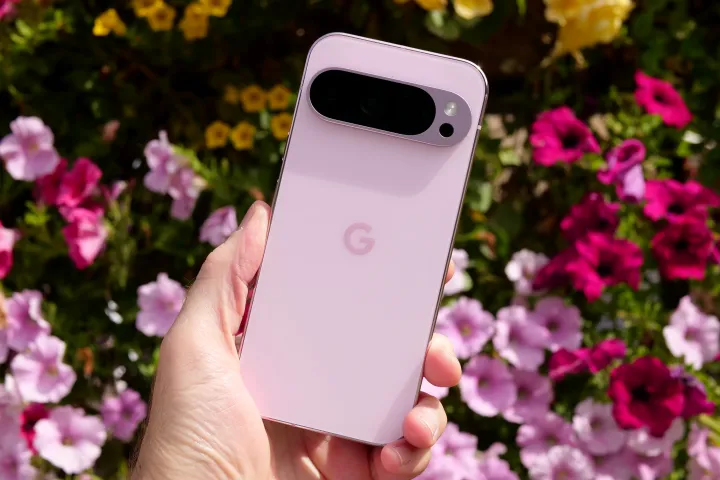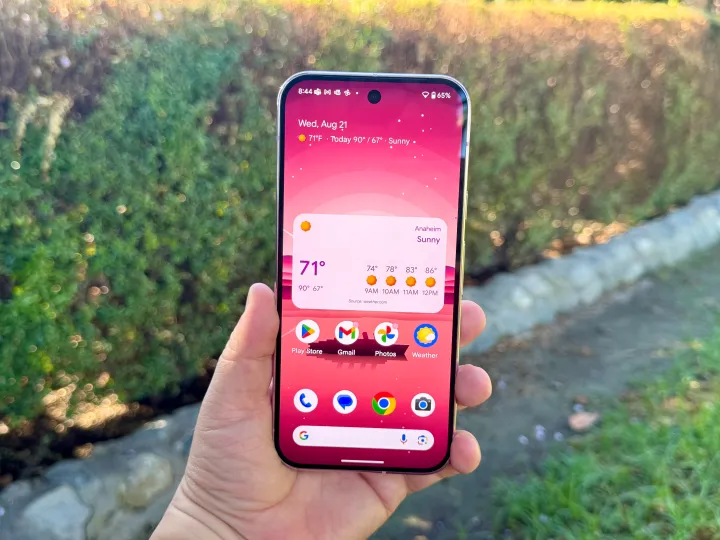Google has introduced the Google Pixel 9 Pro XL, the first XL Pixel model since 2019. How different is it from the also recently introduced Pixel 9 Pro? Perhaps not nearly as much as you might expect. In fact, there are only two main differences between the two smartphones — but they are important differences, and will likely be deciding factors in which of the two you eventually buy.
Let’s take a closer look with this comparison between the Pixel 9 Pro and the Pixel 9 Pro XL to better understand the nuances and differences between these two new offerings from Google.
Google Pixel 9 Pro vs. Pixel 9 Pro XL: specs
| Google Pixel 9 Pro | Google Pixel 9 Pro XL | |
| Dimensions | 152.8 x 72.0 x 8.5 mm (6.0 x 2.8 x 0.3 inches) | 162.8 x 76.6 x 8.5 mm (6.4 x 3.0 x 0.3 inches) |
| Weight | 199 grams (7.01 ounces) | 221 grams (7.8 ounces) |
| Display | 6.3-inch Super Actua LTPO 1280 x 2856 pixels 1-120Hz Dynamic refresh rate HDR10+ 3,000 nits peak brightness |
6.8-inch Super Actua LTPO 1344 x 2992 pixels 1-120Hz Dynamic refresh rate HDR10+ 3,000 nits peak brightness |
| Durability | IP68 | IP68 |
| Colors | Obsidian black, Porcelain white, Hazel green, Rose Quartz pink | Obsidian black, Porcelain white, Hazel green, Rose Quartz pink |
| Processor | Google Tensor G4 | Google Tensor G4 |
| RAM | 16GB | 16GB |
| Storage | 128GB, 256GB, 512GB, 1TB | 128GB, 256GB, 512GB, 1TB |
| Software | Android 14 | Android 14 |
| Updates | Seven years of promised upgrades | Seven years of promised upgrades |
| Rear cameras | 50-megapixel primary, f/1.68 aperture, 1/1.31-inch sensor size, OIS
48MP ultrawide, f/1.7, 123° field of view 48MP telephoto, f/2.8, 5x optical zoom, 1/2.55-inch sensor |
50MP primary, f/1.68 aperture, 1/1.31-inch sensor size, OIS
48MP ultrawide, f/1.7, 123° field of view 48MP telephoto, f/2.8, 5x optical zoom, 1/2.55-inch sensor |
| Front camera | Selfie camera: 42MP selfie camera, autofocus, 123-degree field of view | Selfie camera: 42MP selfie camera, autofocus, 123-degree field of view |
| Battery | 4,700mAh | 5,060mAh |
| Charging | 27W wired charging 21W wireless charging Reverse wireless charging |
37W wired charging 23W wireless charging Reverse wireless charging |
| Price | Starting at $999 | Starting at $1,099 |
| Review | 4.5 out of 5 stars | 4.5 out of 5 stars |
Google Pixel 9 Pro vs. Pixel 9 Pro XL: design and display

Google has made significant design changes to the entire Pixel 9 lineup, which also includes the regular Google Pixel 9 and Pixel 9 Pro Fold. The changes include rounder bodies, flatter mid-frames, and consistent colors on the metal and glass sections.
When comparing the Pixel 9 Pro and Pixel 9 Pro XL side by side, the only design difference you’ll notice is the display size. The Pixel 9 Pro features a 6.3-inch Super Actua LTPO display, while the Pixel 9 Pro XL boasts a 6.8-inch Super Actua LTPO display. Due to this crucial difference, the dimensions and weight vary between the two models, as does the display resolution.
But beyond this, the similarities are striking. The Pixel 9 Pro and Pixel 9 Pro XL offer the same color choices: Obsidian black, Porcelain white, Hazel green, and Rose Quartz pink. Both phones’ displays have an impressive dynamic refresh rate of up to 120Hz, support HDR10+, and boast a lovely peak brightness of 3,000 nits.
These displays are protected by Corning Gorilla Glass Victus 2, the latest and most durable type of Gorilla Glass available, providing improved scratch and drop resistance compared to previous generations.
One final similarity in terms of the body between the phones is the IP68 rating. This means the devices are dust-tight and allow for immersion in up to five feet of water for up to 30 minutes.
Google Pixel 9 Pro vs. Pixel 9 Pro XL: cameras

Google Pixel phones have always had impressive cameras, and the same can be said for the cameras found on both of these Pro phones, which have identical systems. And yet, most of the sensors are similar to what was found on the Pixel 8 Pro, which is only something to keep in mind if you’re considering upgrading from that model.
Like last year, you’ll get a 50-megapixel primary camera, a 48MP ultrawide camera, and a 48MP telephoto camera. On the front, instead of the 10.5MP sensor found on last year’s model, the selfie camera on the Pixel 9 Pro model is 42MP.
We were impressed with the Pixel 9 Pro and Pixel 9 Pro XL’s cameras, although we were disappointed there were no changes made on the rear side. However, the selfie camera was the best we had used all year.
Even though the Pixel 9 Pro series has only a few hardware changes from last year’s Pro models, it offers a fair share of AI tools. Some of these are exclusive to the series at launch. With “Add Me,” for example, if you’re taking a picture of your friends, but there’s no one to hold your phone so you can be in the picture, you can use the Pixel 9 to create a composite of two images to insert yourself in the picture.
Other AI features that will use Pixel cameras will likely be introduced in the coming year that will further divide this year’s Pixels from last year’s. But for these two particular models, there are no differences.
Google Pixel 9 Pro vs. Pixel 9 Pro XL: performance

This is the fourth year that Google has used an in-house Tensor G chipset inside its Pixel lineup of phones. While earlier versions largely missed the mark, the Tensor G3 in last year’s model was seen as a noticeable step up. Not surprisingly, more improvements have arrived with the Tensor G4 used in this year’s model.
The chip is considered reliable, with smooth navigation and no overheating, regardless of what you’re doing on the phone. The increased RAM also aids in even better performance. Instead of the 12GB found in the Pixel 8 Pro, this year’s Pro models have 16GB of RAM.
During our tests, we found that the Tensor G4, coupled with the 16GB of RAM, allowed apps to open smoothly and graphically intensive games to run without a hitch. So it’s a big win for Google — but once again, there’s no difference between these two. You’ll get strong performance either way.
Google Pixel 9 Pro vs. Pixel 9 Pro XL: battery and charging

The Pixel 9 Pro and Pixel 9 Pro XL differ in battery and charging capabilities. Both models have addressed previous criticisms of poor battery life in Pixel phones and perform well.
The Pixel 9 Pro has a 4,700mAh capacity battery, which Google claims can last up to 24 hours with regular use. Lighter usage may extend this to about a day and a half. Enabling Extreme Battery Saver mode can stretch this to 100 hours between charges.
The Pixel 9 Pro comes with a USB-C cable, but no power adapter. It supports fast charging at a speed of 27 watts, providing approximately 55% charge in 30 minutes or a full charge in 90 minutes.
For wireless charging, the Pixel 9 Pro can achieve speeds of up to 21W with the second-generation Google Pixel Stand or 12W with standard Qi-certified wireless chargers. There’s also reverse wireless charging. However, Google decided not to include Qi2 support this year.
The Pixel 9 Pro XL features a 5,060mAh battery, similar to the 5,050mAh battery in the Pixel 8 Pro. The improved power efficiency of the new phone allows for better battery life compared to its predecessor. During tests, it was possible to usually squeeze one-and-a-half days between charges, likely aided by the Tensor G4 chip. Despite this improvement, it still falls short compared to competitors like the Samsung Galaxy S24 Plus and OnePlus 12.
The Pixel 9 Pro XL recharges at up to 37W, slightly better than the 30W on the Pixel 8 Pro, but it still needs to be faster for a phone at this price point. It took about 90 minutes to go from 0 to 100% compared to the 30 minutes for a full charge on the OnePlus 12R.
Wireless charging for the Pixel 9 Pro XL maxes out at 12W with regular Qi chargers and up to 23W with the Pixel Stand 2. Like the Pixel 9 Pro, there’s reverse wireless charging, but Qi2 support remains unavailable on these devices.
Google Pixel 9 Pro vs. Pixel 9 Pro XL: software and updates

New Pixel phones typically come with the latest version of Android. However, due to Android 15 not being available yet, buyers will receive Android 14. Google promises Pixel 9 owners seven years of software updates, which means they’ll receive every Android version through at least Android 21 or 2031.
In addition to the software updates, new Pixel users will also receive some new software-related features. These include a new Pixel Weather app that uses AI to provide up-to-date reports; Pixel Screenshots, which reduces clutter in your camera roll; and Gemini, which replaces the legacy Google Assistant. Users of Pixel 9 Pro devices (including the XL and Fold) will receive a year of Gemini Advanced for free. In contrast, regular Pixel 9 users can get a one-month trial of Gemini Advanced and Pixel Studio, an AI image-generation app.
Users will also receive a one-year free subscription to Gemini Advanced, granting access to Gemini Live. This feature offers a conversational experience with Gemini, allowing users to have a flowing conversation with Gemini as if it were an actual person.
Google Pixel 9 Pro vs. Pixel 9 Pro XL: which should you choose?

The Pixel 9 Pro and Pixel 9 Pro XL are priced only $100 apart from each other. For the extra cost, you’ll get a larger display and a bigger battery. Other than that, the phones are identical, with similar camera features, processors, RAM, storage options, and software experience.
If you prefer a larger display, choose the Pixel 9 Pro XL. If you have no preference and are OK with spending an extra $100, the choice is also the Pixel 9 Pro XL. For those with a 6.7-inch Pixel 8 Pro, the choice is also the 6.8-inch Pixel 9 Pro XL. For a smaller option, go with the Pixel 9 Pro. Regardless, neither option is a wrong choice, as they’re both excellent smartphones.


